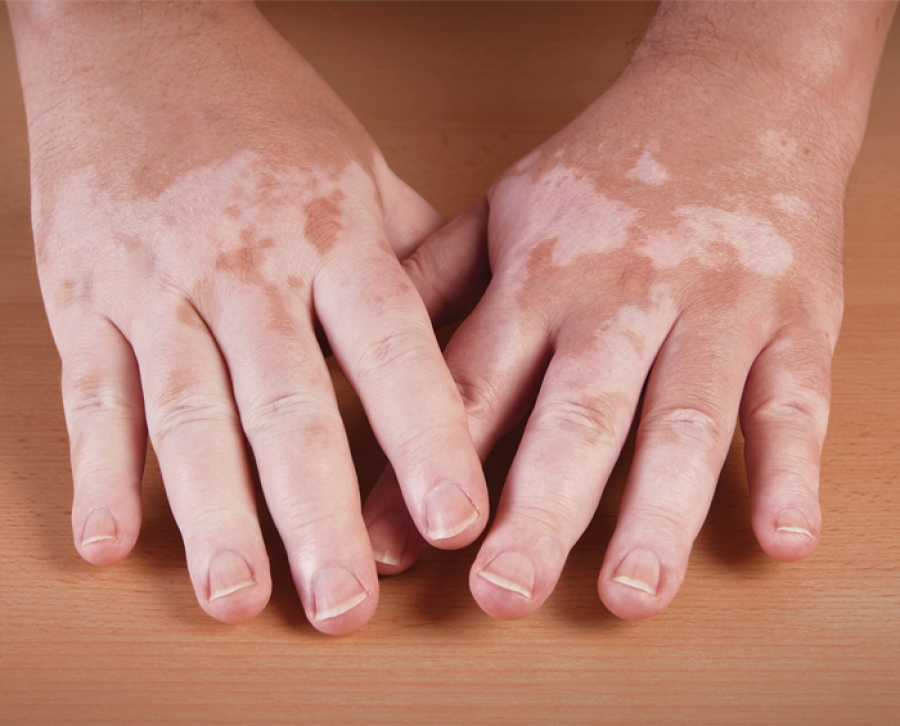- Vitiligo can affect small, isolated areas of skin anywhere on the face or trunk or may cause depigmentation of nearly all skin on the body.
- There has been some success in repigmenting small areas of depigmentation by transplanting, in vitro, cultured melanocytes. If the transplant is successful, the skin will repigment normally.
- Vitiligo can also be associated with three other autoimmune diseases such as Addison’s disease, hypothyroidism and pernicious anemia.
- Seborrheic dermatitis is an inflammatory skin disease characterized by red, scaly, itchy patches of skin. In some cases, these areas may be left hypopigmented.
- Vitiligo affects up to two percent of the population. There may be a genetic connection in relation to vitiligo as it tends to run in families. It generally affects all races equally but it is more noticeable in individuals who have a darker skin complexion.

- Certain skin types may be more prone to either hyperpigmentation (darker pigment) or hypopigmentation due to their complexion. These individuals need to be very cautious when considering skin treatments such as Intense Pulsed Light (IPL) lasers and chemical peels. These procedures may cause areas of permanent hypopigmentation.

- The most common cause of non-hereditary or non-autoimmune hypopigmentation is damage or trauma to the skin. This can include burns, skin infections, acne, blisters, scrapes or any injury that can result in scarring and loss of pigmentation.

- Albinism is another form of hypopigmentation that is a rare, inherited disorder caused by the absence of an enzyme that produces melanin. As a result, there is a lack of pigmentation of the skin, hair and eyes. Since albinos have an abnormal gene that does not allow them to produce pigment, there is no cure for albinism.

- Hydroquinone is a common topical agent used to even or lessen pigment production in hyperpigmented skin areas due to genetics, cumulative sun exposure or melasma. Higher, prescription percentages of hydroquinone, when used appropriately, can occasionally damage pigment cells and may cause spots or areas of hypopigmentation.

- In recent years, certain lasers have been engineered to repigment smaller areas of hypopigmented skin or even hypopigmented stretch marks and surgical scars. While the exact mechanism of action is not clearly understood, it appears that if the pigment cells have not been completely destroyed, those devices may stimulate some degree of repigmentation.
Loss of pigment can be psychologically and socially traumatizing. While the majority of causative factors may result in permanent pigment loss, lasers and flesh colored tattooing can offer some long-term improvement. Although genetics and certain diseases may be unavoidable, there is a significant preventative factor that should be taken into consideration. The use of lasers, peels, microdermabrasion and topical drugs should be analyzed and considered cautiously, and the potential risks thoroughly evaluated by a skilled professional.
 Jan Marini, president and CEO of Jan Marini Skin Research, Inc., is one of the most respected names in skin care. Her passionate commitment to healthy skin as an educator, innovator and product researcher, prompted one journalist to dub her “The Derma Diva.” Marini pioneered medically-validated skin care preparations and has formed associations with some of the world’s leading physicians and research scientists. In addition to being a sought-after speaker for medical conferences and beauty industry events, Marini has also spoken at the Royal Society of Medicine in London, American Academy of Dermatology, and the Society of Plastic Surgical Skin Care Specialists.
Jan Marini, president and CEO of Jan Marini Skin Research, Inc., is one of the most respected names in skin care. Her passionate commitment to healthy skin as an educator, innovator and product researcher, prompted one journalist to dub her “The Derma Diva.” Marini pioneered medically-validated skin care preparations and has formed associations with some of the world’s leading physicians and research scientists. In addition to being a sought-after speaker for medical conferences and beauty industry events, Marini has also spoken at the Royal Society of Medicine in London, American Academy of Dermatology, and the Society of Plastic Surgical Skin Care Specialists.
